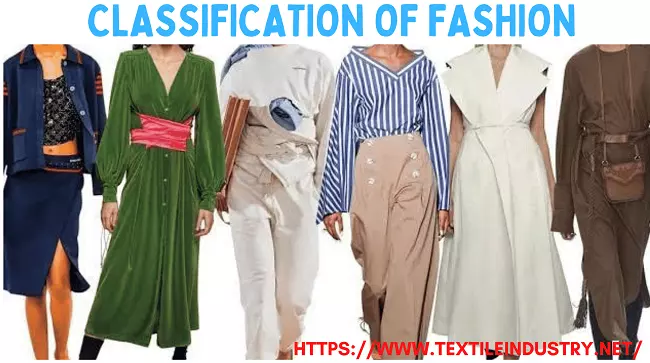Fashion is a means of self-expression and autonomy in a given time and place in a specific environment. It includes clothes, footwear, accessories, cosmetics, and much more. Fashion has the power to both shape and also be shaped by society and is frequently seen as a reflection of the social and cultural views of a particular period and location. Here I present the Classification of Fashion in Details Description, hope you would love to read this.
Fashion is a trend that changes from individual-to-individual day to day, from time to time as well as from culture to culture. “FASHIONISTA” or “Fashion Victim” is a term that means someone who slavishly copies the latest fashion trends. The fashion system makes anything that is deemed fashion accessible and appealing.
Fashion includes the prevailing fashions, behavioral tendencies, and mentalities that influence how individuals express themselves outwardly through their appearance. Fashion is a broad category that covers hairstyles, cosmetics, and even household items in addition to clothing. Additionally, fashion serves as a vehicle for communicating with others and for self-expression.

Classification of Fashion in Detail
Fashion can be categorized in a number of ways to better comprehend as well as identify the numerous types and designs that exist within the business. Let’s explore the classification of fashion in further detail now.
1. Style
Style is a concept that may be interpreted in several ways. Some claim that it’s your appearance, while others assert that it’s who you are on your insides. A distinctive and individual approach to clothes and accessories, as well as the overall look, indicates style in the world of fashion. Style never changes, as well as is not subject to fads like fashion. In fact, it is a change in fashion.
Style may refer to anything that gives a person a fashionable appearance and is not just tied to clothing. Another way of looking at style is as a non-changing extension of fashion. A person’s individual fashion sense is created through the blending of several components, including color, silhouette, fabric, and design. Style is a reflection of an individual’s uniqueness and may be a potent means of self-expression.
2. Fad Fashion
Fad Fashion is a trend that only lasts for a little time, usually one season. It is primarily a novelty that is adopted for a brief period of time by a select set of individuals, frequently young people, particularly young ladies, and early adopters, as it garners attention from peers or the media. You have a fantastic and humorous illustration if you can recall the pet rock craze. However, people become disinterested in it very fast.
3. Fashion Forecasting
The term “Fashion Forecasting” involves predicting consumer mood, behavior, as well as purchasing patterns. The idea is applicable not just to one level of the fashion business but to every single one of them, from modest box stores to enormous high-end fashion brands or companies. Fashion forecasting tries to advise customers, merchants, manufacturers, and designers about what will be fashionable in the future.
Fashion forecasting includes elements of design, psychology, market research, and trend analysis. To spot developing trends and predict what will be popular in the future, forecasters assemble information from a range of sources, such as consumer surveys, trade events, fashion shows, and street-style photography.
4. Basic or Classic
The term “classic fashion” describes trends that have been popular for a long time and have a timeless appeal. These fashions are distinguished by their simplicity, elegance, and adaptability, and they frequently use muted hues, crisp lines, and traditional shapes. Little black dresses, white shirts, as well as trench coats are examples of basic clothing pieces that are regarded as essentials for a classic wardrobe.
Classic fashions are a sensible investment for people who value quality above trendiness since they last and may be worn season after season. Because it is adaptable and can be dressed up or down to fit any occasion, classic fashion is frequently preferred by individuals who want to look polished and sophisticated.
5. Fashion trends
Fashion trends are the looks as well as patterns that are in vogue in the fashion world right now. Color schemes, patterns, materials, and shapes are a few examples of trends frequently representing societal, economic, and cultural shifts. Fashion trends may change quickly and affect various things, including celebrity style, high fashion catwalk displays, and street style.
While some trends are transient, others persist for a longer period of time. The fashion industry uses trend forecasting to foresee future trends and also direct product development and buying choices. Consumers enjoy fashion trends because they allow them to express their styles and stay up with the most recent trends.
Wrap-Up: In conclusion, now you may be clear about the topic “What Is Fashion.” Fashion is a means of self-expression and autonomy in a given time and place in a specific environment. Fashion gives countless options for expressing oneself and one’s personality, whether you choose to keep up with the most recent trends or develop your own distinctive look.
- You may love to read: What is Fashion | Classification of Fashion with Description
